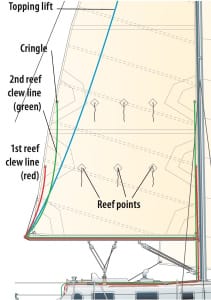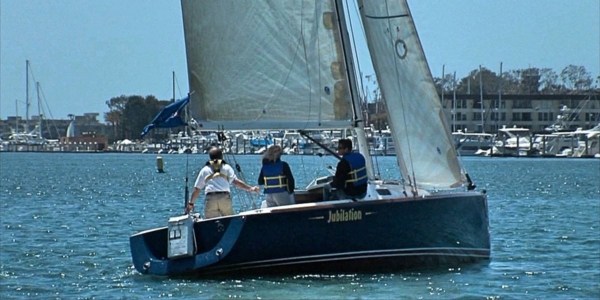The sailing season is upon us! Air temps are coming up, the water is warming up and you haven’t put on a pair of long-pants for at least six weeks. Well, some of us have not. Sailing is part of your weekly routine now and sometimes your face actually gets sore from the constant smiling. This is all great – we endorse this of course, but sometimes it’s this very euphoria that can lead to a complacency that could end in problems. We don’t want that. We’re talking about reefing – a foreign concept for some, a tried and failed practice for others, a studied and untried theory for the academics in the house and an important and often used skill for real sailors.
The truth is, weather reports can be inaccurate or not consulted at all. It’s a beautiful day and that’s all some need to go on. But one of the fun things about sailing is the surprise the weather God can supply. For the skilled and knowledgeable, it’s an adjustment. For everyone else it can be, at the least, upsetting and at the worst, tragic. Let’s get you in the club of the former.
How to reef

A typical sequence of sail combinations for increasing wind strength
Most boats are equipped with the ability to subtract sail area from the rig (reef) for when the wind pipes up. Since this system is built into the design of the boat, once reefed, she’ll sail on quite happily in this added amount of breeze. So many people don’t know how to reef their boats and enter into an ugly battle once the boat becomes overpowered. It heels way over and is very difficult to steer. The loads are stacked up everywhere and things don’t feel nice at all.
 So let’s not go through all that – let us be reefing people. To begin, look at the boat while she’s sitting peacefully at the dock, head up into the wind and peruse the boom. Identify where everything leads and specifically where the reefing mechanisms and/or lines reside. If it looks too confusing, find someone with a big brain or hit up the Internet until you know how to put a reef in, there at the dock. Typically it involves lowering the sail a few feet and tying up the extra material in some fashion onto the boom, thereby establishing a new tack and clew. Figure it out and put in a reef, then shake it out. Do this a few more times until you get used to the mechanics because the real-life version will be a little less stable and predictable an environment.
So let’s not go through all that – let us be reefing people. To begin, look at the boat while she’s sitting peacefully at the dock, head up into the wind and peruse the boom. Identify where everything leads and specifically where the reefing mechanisms and/or lines reside. If it looks too confusing, find someone with a big brain or hit up the Internet until you know how to put a reef in, there at the dock. Typically it involves lowering the sail a few feet and tying up the extra material in some fashion onto the boom, thereby establishing a new tack and clew. Figure it out and put in a reef, then shake it out. Do this a few more times until you get used to the mechanics because the real-life version will be a little less stable and predictable an environment.
For more details refer to our Coastal Cruising Made Easy textbook.
When to reef
Once you’ve familiarized yourself with the how-to’s of your particular reefing set-up, now understand when it needs to be employed. There’s an old sailor saying that says, “Once you’ve realized it’s time to reef, it’s too late.” Another one is: “The time to reef is when you first think about it.” You get the idea…Wind comes up fast and reefing in a gale (or close to it) is a recipe for disaster.
All boats are different so it’s hard to say exactly what exact wind-speed deserves a reef, but many agree that 15-knots is certainly a point where many boats are either reefed or thinking about it. Another factor is what point of sail you happen to be on. It’s important to understand that sailing downwind in 15-knots of wind will be pretty comfy, but if you have to turn upwind, the apparent wind is going to change the dynamic drastically.
In this age of roller furling jibs and mains, particularly jibs, many sailors have the benefit of first rolling in some of the headsail to depower as the wind increases. If you’ve done that, know that reefing the main may very well be the next step. It’s a good idea to speak with someone familiar with the boat’s design and get good information on how your particular boat and rig likes to be reefed – where the balance is. Finding that sweet spot and being unfazed by the idea of reefing is the difference between continuing on with a great day of sailing and being terrified. Be the continuing-on-with-a-great-day sailing person…
The Art of Sailing
- Understanding Points of Sail The direction of the wind dictates the direction a sailboat can sail. The Points of Sail describe the range of courses a sailboat can and cannot travel.
- Understanding the Sails The sail is the driving force of the boat. A sailboat is only as good as its sails when you consider that capturing the wind’s energy is the premise behind what sailors do to propel their boats in a forward direction.
- Understanding the Wind A sailor’s world revolves around the wind and staying aware of the wind’s direction is crucial. Your ability to accurately sense changes in the wind, its speed and its direction will improve as you learn.












